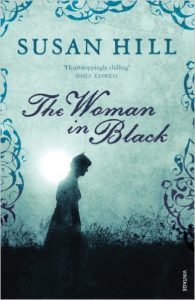The Woman in Black By Susan Hill
 If you are looking for a good ghost story, The Woman in Black by Susan Hill should be right up your street. Especially if you like ghost stories set in spooky, old houses. In fact, there are lots of reasons to read The Woman in Black, in this book review I’m going to give you an idea of what to expect.
If you are looking for a good ghost story, The Woman in Black by Susan Hill should be right up your street. Especially if you like ghost stories set in spooky, old houses. In fact, there are lots of reasons to read The Woman in Black, in this book review I’m going to give you an idea of what to expect.
The Woman in Black is written in the first-person, from the perspective of Arthur Kipps. It’s not a long book. My paperback copy was only 160 pages long. If you are a diligent reader, or simply have a lot of time to kill, you could probably read the book from beginning to end in a single sitting.
The first chapter of the book starts off a little slow, but it does a good job of arousing curiosity and will soon have you wondering what has happened to Arthur Kipps. You will also become increasingly eager to learn about the story Arthur is trying to lay to rest as he places it on paper throughout the rest of the book.
If you’ve seen the TV movie that was made in 1989, you may notice a few minor differences between it and the book. In 2012, Hammer made a Woman in Black Film too. Daniel Radcliffe took the starring role. If you are familiar with that version, the differences you notice will be considerably more. It fails to do justice to Susan Hill’s book.
When I read the Woman in Black, I’d already seen the TV dramatization so I knew the answers already. However, that did not spoil my enjoyment of the book.
Most of the story is set at a place called Eel Marsh House. The former resident, Alice Drablow, has died and there is nobody to mourn her. She had no friends or family and spent her final years living as a recluse.
The firm of solicitors Arthur works for asks him to go to the village of Crythin Gifford and be the company’s representative at Mrs Drablow’s funeral. She was a client so there is also an additional task for Arthur to do. After the funeral, he has to visit Eel Marsh House, sort through Mrs Drablow’s papers, and then forward the important ones.
Eel March House is an unusual place. It’s situated on an island that can only be accessed via a narrow and dangerous path called Nine Lives Causeway. To complicate matters further, the causeway is only accessible for a few hours each day, when the tide is out. To make things more difficult, there are marshes on either side of the causeway and the whole area is prone to sudden fogs (called frets). They swirl in from the sea without warning, so you can well imagine the difficulties Arthur might have if he suddenly needed to leave the island.
From his very first contact with the people of Crythin Gifford, Arthur realizes that there is some sort of superstitious belief surrounding Eel Marsh House and its former owner. I don’t want to give too much of the plot away in this book review, but there’s a good chance you will have already guessed the fear in the village is due to a mysterious woman in black.
Arthur encounters the woman in black for the first time at Alice Drablow’s Funeral. She stands at the back of the church—a solitary mourner wearing an old-fashioned black dress and bonnet. Her skin is very white and stretched tightly over her bones. The woman in black looks so unwell Arthur thinks she must be suffering from a wasting disease.
The Second time Arthur sees the woman in black is within the grounds of Eel Marsh House. She’s standing in the ruins of the family graveyard. It’s during this encounter that Arthur first senses the malevolence that emanates from her. When Arthur wrestles with his fear and goes to confront the woman she disappears.
Who is the woman in black? What was the accident on the causeway, that Arthur hears re-enacted in the fog? Perhaps more worryingly, what is making the noises he hears coming from a locked room at the end of one of the corridors? These are all things that Arthur wants to find out. But when he does learn the truth of what has only previously been hinted, will Arthur be strong enough to take the consequences? If you want to know the answer to these questions, reading the book is the best way to find out. It’s one of the best ghost stories I’ve ever read. If you do read it, you may find yourself saying the same thing as well.
~~~
